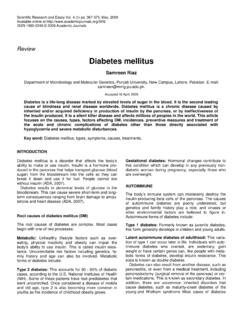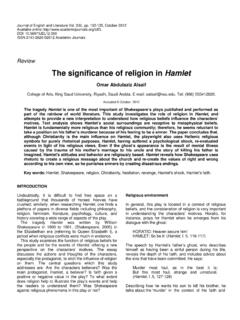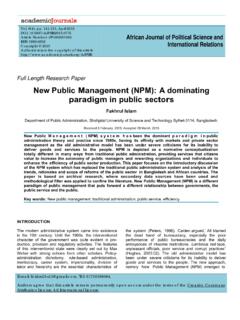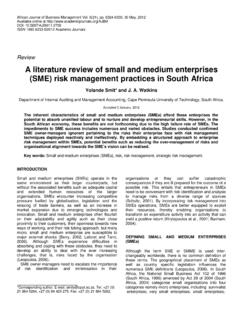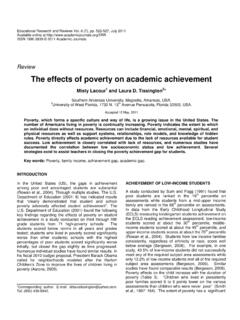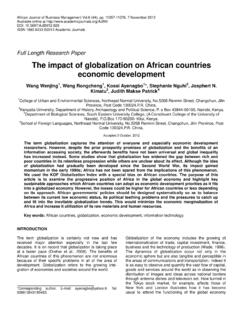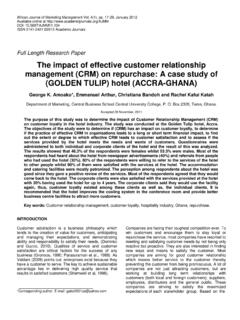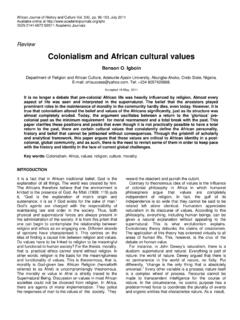Transcription of Ancient Egyptian Medicine - Academic Journals
1 Journal of Medicinal Plants Research Vol. 4(2), pp. 082-086, 18 January, 2010 Available online at DOI: ISSN 1996-0875 2010 Academic Journals Review Herbal Medicine in Ancient Egypt N. H. Aboelsoud Department of Complementary Medicine Researches and Applications National Research Center- Cairo, Egypt. E-mail: Accepted 8 December, 2009 Civilization in Ancient Egypt was not only the pyramids and tombs, but it involved all aspects of human life. Health and wellbeing was one of the most cared arts by the pharaohs. Both the physicians and magicians participated in the field of medical care. From holistic view they conceived health and sickness as an unceasing fight between good and evil. Most of the complementary Medicine modalities were originated from Ancient Egyptians.
2 One of these modalities is herbal Medicine , which is the subject we are going to spot light on in this review. Our comments depended on what Ancient Egyptians recorded in their medical papyri . Key words: Ebers papyrus, medicinal plants, remedies, prescriptions, Ancient Egypt. INTRODUCTION Not all of Egyptian Medicine was based on wishful thinking, much was the result of experimentation and observation, and physical means supplemented the magical ones. Apart from spiritual healing and herbal Medicine , Ancient Egyptians practiced massage and manipulation and made extensive use of therapeutic herbs and foods, but surgery was only rarely part of their treatments (Zucconi, 2007). According to Herodotus there was a high degree of specialization among physicians (Halioua et al.)
3 , 2005). The Egyptians were advanced medical practitioners for their time. They were masters of human anatomy and healing mostly due to the extensive mummification ceremonies. This involved removing most of the internal organs including the brain, lungs, pancreas, liver, spleen, heart and intestine (Millet et al., 1980). To some extent, they had a basic knowledge of organ functions within the human body. Their great knowledge of anatomy, as well as (in the later dynasties) the crossover of knowledge between the Greeks and other culture areas, led to an extensive knowledge of the functioning of the organs, and branched into many other medical practices. Herodotus and Pliny were among Greek scholars, who got benefit from this cross over and further contributed to the Ancient and modern medical records, reached from the time of Ancient Egypt and into the modern era (Sanders, 1963).
4 Ancient Egyptians were as equally familiar with phar-macy as they were with Medicine . According to historical records, Ancient Egyptians involved in the medical and pharmaceutical profession used to recite certain incan-tations while preparing or administering medications. They were also familiar with drug preparation from plants and herbs such as cumin, fennel, caraway, aloe, saf-flower, glue, pomegranates, castor and linseed oil. Other drugs were made of mineral substances such as copper salts, plain salt and lead. Eggs, liver, hairs, milk, animal horns and fat, honey and wax were also used in drug preparation (Rosen, 1979). In this review we spot some light on Ancient Egyptian Medicine particularly herbal remedies and prescriptions to prove that they are in fact the basis of our natural Medicine .
5 SOURCES OF KNOWLEDGE OF Ancient Egyptian MEDICAL LIFE A few papyri have survived, from which we can learn about Egyptian Medicine (Nunn, 1996): - The Edwin Smith Papyrus describing surgical diagnosis and treatments, - The Ebers Papyrus on ophthalmology, diseases of the digestive system, the head, the skin and specific mala-dies, a compilation of earlier works that contains a large number of prescriptions and recipes, - The Kahun Gynaecological Papyrus, - The Berlin Medical Papyrus, - The London Medical Papyrus. - The Hearst Medical Papyrus repeats many of the recipes found in the Ebers Papyrus. - The Demotic magical Papyrus of London and Leiden contains a number of spells for treating physical ailments Thanks to the medical papyri , we know of many of the Ancient Egyptian treatments and prescriptions for diseases.
6 They call for the treatment of many disorders and the use of a variety of substances, plant, animal, mineral, as well as the droppings and urine of a number of animals. They knew how to use suppositories, herbal dressings and enemas and widely used castor oil (Majno, 1975). A great deal of our knowledge of Ancient Egyptian Medicine comes from the Edwin Smith Papyrus, the Ebers Papyrus and the Kahun Papyrus. The Edwin Smith Papyrus (Breasted, 1930) and the Ebers Papyrus (Bryan, 1930) date from the seventeenth and sixteenth centuries BCE. These manuscripts are believed to be derived from earlier sources. They contain recipes and spells for the treatment of a great variety of diseases or symptoms. They discuss the diagnosis of diseases and provide infor-mation of an anatomy.
7 They detail the Ancient Egyptian concept of Medicine , anatomy, and physiology .The Kahun Papyrus (Ghalioungui, 1975) is a gynecological text that deals with topics such as the reproductive organs, conception, testing for pregnancy, birth, and con-traception. Among those materials prescribed for contraception are crocodile dung, honey, and sour milk (Rosalie and Patricia, 2008). COMMON DISEASES IN Ancient EGYPT Among the common everyday complaints were stomach upsets, bowel trouble and headaches which could go away probably mostly untreated, even if the physicians could offer remedies. The common cold had a special remedy, the milk of a mother who has given birth to a boy, was probably as effective as anything we have got today (Jean-Claude, 1979).
8 Bilharziasis (schistosomiasis) - a disease difficult not to contract in a country flooded for months every year - a common cause of anemia, female infertility, a debilitating loss of resistance to other diseases and subsequent death. The Ebers Papyrus addresses some of the symptoms of the disease and in two columns discusses treatment and prevention of bleeding in the urinal tract (haematuria). The Hearst Papyrus cites antimony disulfide as a remedy (Hamed, 2009). Insect borne diseases like malaria and trachoma were endemic; plagues spread along the trade routes and a number of epidemics reported in Egyptian documents are thought by some to have been outbreaks of bubonic plague. Mosquitoes also spread filarial worms which caused the disfiguring elephantiasis.
9 Smallpox, measles, and cholera were easily propagated in the relatively densely populated Nile valley, where practically the whole population lived within a narrow strip of land, sometimes only a few hundred meters wide, along the river Aboelsoud 083 (Sandison, 1980). HERBAL Medicine Herbs played a major part in Egyptian Medicine . The plant medicines mentioned in the Ebers Papyrus for instance include opium, cannabis, myrrh, frankincense, fennel, cassia, senna, thyme, henna, juniper, aloe, linseed and castor oil - though some of the translations are less than certain. Cloves of garlic have been found in Egyptian burial sites, including the tomb of Tutankhamen and in the sacred underground temple of the bulls at Saqqara.
10 Many herbs were steeped in wine, which was then drunk as an oral Medicine (Patrick et al., 2009). Egyptians thought garlic and onions aided endurance, and consumed large quantities of them. Raw garlic was routinely given to asthmatics and to those suffering with bronchial-pulmonary complaints. Onions helped against problems of the digestive System. Garlic was an important healing agent then just as it still is to the modern Egyptian and to most of the peoples in the Mediterranean area: Fresh cloves are peeled, mashed and macerated in a mixture of vinegar and water. This can be used to gargle and rinse the mouth, or taken internally to treat sore throats and toothache. Another way to take garlic both for prevention as well as treatment is to macerate several cloves of mashed garlic in olive oil.
